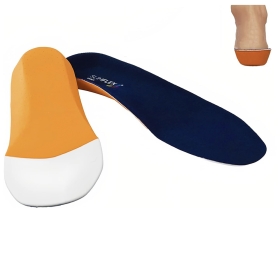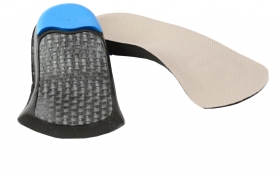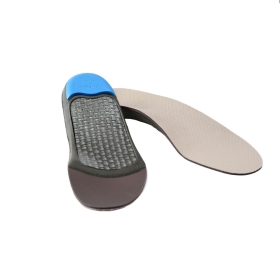Slimflex Carbon Supination Control Insoles - Prevents Foot Rolling Outwards and Supports Arch
This orthotic insoles has a rigid thermoplastic rearfoot base that controls foot, preventing the foot rolling outwards - also known as Supination or Under Pronation. Proven solution, that helps gait.
Product Description
An EVA orthotic insoles with a quick dry, moisture absorbing covering material and a carbon effect nylon base that provides additional functional support and superb heel cradling.
The rigid base makes this insole ideal for heavier patients. This insole can be used in conjunction with Slimflex wedges and Podotech components for a customised device.
Full Lateral Control: The orthotic insoles has a rigid thermoplastic rearfoot base that controls foot, preventing the foot rolling outwards - also known as Supination or Under Pronation. Proven solution, that helps gait.
True Supination Orthotic Insoles: Many orthotic insoles claim to prevent supination, but they don’t, they simply help flat footed people. Slimflex Carbon with lateral support just works helping with associated problems too.
Unique Orthotic Insoles Design: Biomechanical 3D design utilises advanced materials to provide support and stability for the foot, helping prevent ailments linked to ‘rolling’ such as heel pain, plantar fasciitis and blistering.
Cushioning System: Featuring signature comfort cushioning for superior shock absorption, these orthotic insoles will help keep feet aligned but also fatigue free. Orthotic Insoles for women and men, children and adults.
Durable Quality: Supination Orthotic Insoles are made from robust, high-quality materials designed to last multiple years even under heavy usage conditions ensuring your feet have ultimate comfort every step of the way.
Slimflex Carbon Orthotic Insoles Features:
- Ideal initial introduction to orthotic therapy, which offers greater shell control due to its rigid nylon base; perfect for first line treatment.
- EVA device with a rigid nylon base and a deep heel cup which allows greater foot control and correction on its own and when used with wedges.
- Quick dry, moisture absorbing covering material.
- By itself, it provides support to the medial and lateral arch.
- For advanced biomechanical conditions, use in conjunction with Slimflex wedges and Podotech components.
Usage tips:
- Use Slimflex Carbon on its own to control a minimally deviated STJ axis.
- Try using a Slimflex Carbon with a 3.5° rear foot wedge (MOSI).
- Use a Slimflex Carbon with a kinetic wedge for a Functional hallux limitus presentation.







